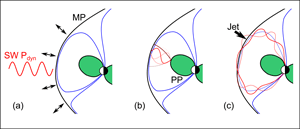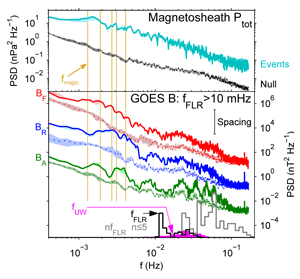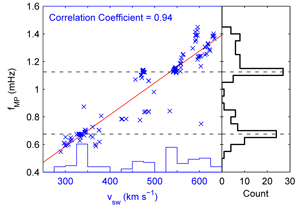
2013 THEMIS SCIENCE NUGGETS
Magnetospheric "magic" frequencies as magnetopause surface eigenmodes
by Martin Archer, Space and Atmospheric Physics Group
The Blackett Laboratory, Imperial College London
Introduction
Statistical and event studies have shown that magnetospheric ultra-low frequency (ULF) waves are often observed at persistent discrete frequencies (roughly 0.7, 1.3, 1.9, 2.6, 3.3 and 4.8 mHz) known as "magic" frequencies. However, the nature of these waves and why their frequencies are so persistent, especially given how variable the magnetosphere is, has been unknown. Three interpretations for "magic" frequencies have been suggested, which are illustrated in Figure 1.
| Figure 1. The three interpretations of magnetospheric "magic" frequencies are a) waves directly driven by the solar wind dynamic pressure; b) global modes between the magnetopause (MP) and plasmapause (PP); or c) standing Alfvénic surface waves of the magnetopause. |
(a) Solar Wind Pressure Oscillations Waves can be directly driven by monochromatic variations in the solar wind dynamic pressure causing the magnetospheric boundary, the magnetopause (MP), to move. Kepko et al. [2002] and Kepko and Spence [2003] argued that the "magic" frequencies are therefore due to some typical length scale in the solar wind.
(b) Global (Cavity/Waveguide) Modes Compressional waves can become trapped between the magnetopause and the plasmapause, the outer boundary of a cold torus of dense plasma, forming a radially standing wave known as a global mode [e.g. Kivelson and Southwood, 1985].
(c) Magnetopause Eigenmodes Plaschke et al. [2009] proposed that standing Alfvénic surface waves of the magnetopause could explain the "magic" frequencies due to the prominence of these frequencies in observations of the oscillating boundary. Such surface waves should have an evanescent wave component inside the magnetosphere and might be triggered by localised jets in the magnetosheath.
To distinguish between these hypotheses, in Archer et al. [2013] we statistically investigated the response of the magnetospheric magnetic field at geostationary orbit to jets in the magnetosheath observed by THEMIS, identified in Archer & Horbury [2013]. There were 130 events where the magnetosheath driver (THEMIS) and magnetospheric response (GOES) could be observed simultaneously at similar local times. We randomly picked the same number of null events also for comparison.
Results
The jets excite broadband enhancements in power compared to null events as well as discrete pulsations at the local field line resonant (FLR) frequencies and the "magic" frequencies (Figure 2). However, the jets are broadband structures with no such discrete power enhancements. Therefore, for these events the "magic" frequencies were not present upstream of the magnetopause and therefore they are inconsistent with interpretation (a).
| Figure 2. Median power spectra of the magnetosheath pressure and magnetospheric magnetic field components (F – field aligned, R – radial, A – azimuthal) for events where GOES was outside the plasmasphere compared to null events (dotted). Distributions of estimated upstream wave (UW) and field line resonance (FLR) frequencies are also shown. |
Discussion
We have shown that the so-called "magic" frequencies are likely resonantly excited natural frequencies of the magnetosphere. By estimating the fundamental frequencies of global modes and magnetopause eigenmodes for these events we distinguish between the two remaining hypotheses.
We find the fundamental frequencies of global modes to be 10-40 mHz, consistent with previous estimates [e.g. Lee and Lysak, 1989] and much higher than the observed "magic" frequencies. The expected magnetopause eigenmode frequencies, however, were found to be highly correlated to the solar wind speed, as shown in Figure 3, and resulted in two preferential frequencies one of which was in excellent agreement with the fundamental "magic" frequency of 0.7 mHz.
| Figure 3. Estimated fundamental magnetopause surface eigenmode frequencies as a function of solar wind speed (crosses) with the distributions of both also shown. |
Conclusion
We conclude that the "magic" frequencies excited by the jets are most likely due to standing Alfvénic surface waves of the magnetopause. The correlation of the surface eigenmode frequency with the solar wind speed is an interesting result and further work could test this.
Reference
Archer, M. O., and T. S. Horbury (2013), Magnetosheath dynamic pressure enhancements: Occurrence and typical properties, Ann. Geophys., 31, 319–331, doi:10.5194/angeo-31-319-2013.Archer, M. O., M. D. Hartinger, and T. S. Horbury (2013), Magnetospheric "magic" frequencies as magnetopause surface eigenmodes, Geophys. Res. Lett., 40, 5003–5008, doi: 10.1002/grl.50979.
Kepko, L., H. E. Spence, and H. J. Singer (2002), ULF waves in the solar wind as direct drivers of magnetospheric pulsations, Geophys. Res. Lett., 29, 1197, doi:10.1029/2001GL014405.
Kepko, L., and H. E. Spence (2003), Observations of discrete, global magnetospheric oscillations directly driven by solar wind density variations, J. Geophys. Res., 108, 1257, doi:10.1029/2002JA009676.
Kivelson, M. G., and D. J. Southwood (1985), Resonant ULF waves: A new interpretation, Geophys. Res. Lett., 12, 49–52, doi:10.1029/GL012i001p00049.
Lee, D.-H., and R. L. Lysak (1989), Magnetospheric ULF wave coupling in the dipole model: The impulsive excitation, J. Geophys. Res., 94, 17,097–17,103, doi:10.1029/JA094iA12p17097.
Plaschke, F., K.-H. Glassmeier, H. U. Auster, O. D. Constantinescu, W. Magnes, V. Angelopoulos, D. G. Sibeck, and J. P. McFadden (2009), Standing Alfvén waves at the magnetopause, Geophys. Res. Lett., 36, L02104, doi:10.1029/2008GL036411.
Biographical Note
Martin Archer is a PhD student in the Space & Atmospheric Physics group at Imperial College London. For more, visit http://www.martinarcher.co.uk
 Please send comments/suggestions to
Emmanuel Masongsong / emasongsong @ igpp.ucla.edu
Please send comments/suggestions to
Emmanuel Masongsong / emasongsong @ igpp.ucla.edu



